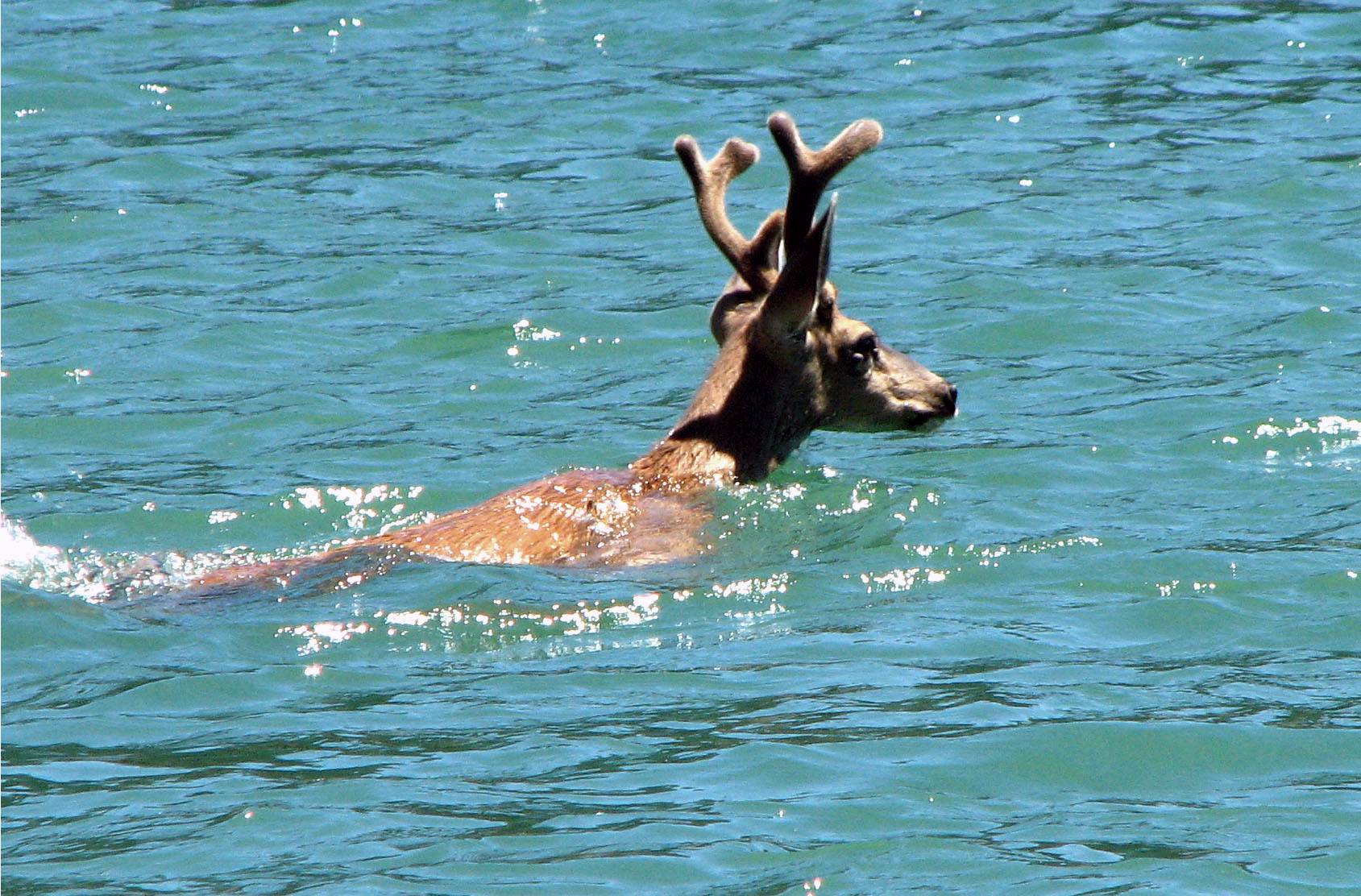|
Hosselkus Limestone
The Hosselkus Limestone is an Upper Triassic fossiliferous marine micrite, micritic limestone Formation (stratigraphy), formation that outcrops in Plumas County, California, Plumas and Shasta County, California, Shasta Counties, California. It is known for its invertebrate fauna, most notably the many species of shelled cephalopods. Geology The geologic column of the nearby Taylorsville, California, Taylorsville region shows the Hosselkus Limestone as 140 ft thick and of Late Triassic (early Karnian) age. It is well exposed near the Cosmopolitan mine on the divide between the Genesee Valley and Hosselkus Creek. It has been recognized at numerous outcrops between Spanish Ranch, California, Spanish Ranch and Prattville and northwestward beyond Pit River in the Klamath Mountains, and is considered to be younger than the Swearinger slates and older than the Trail beds. It contains numerous ''Arcestes'' and abundant pentagonal crinoid stems which indicate it is of Late Triassic age. ... [...More Info...] [...Related Items...] OR: [Wikipedia] [Google] [Baidu] |
Geological Formation
A geological formation, or simply formation, is a body of rock having a consistent set of physical characteristics (lithology) that distinguishes it from adjacent bodies of rock, and which occupies a particular position in the layers of rock exposed in a geographical region (the stratigraphic column). It is the fundamental unit of lithostratigraphy, the study of strata or rock layers. A formation must be large enough that it can be mapped at the surface or traced in the subsurface. Formations are otherwise not defined by the thickness (geology), thickness of their rock strata, which can vary widely. They are usually, but not universally, tabular in form. They may consist of a single lithology (rock type), or of alternating beds of two or more lithologies, or even a heterogeneous mixture of lithologies, so long as this distinguishes them from adjacent bodies of rock. The concept of a geologic formation goes back to the beginnings of modern scientific geology. The term was used by ... [...More Info...] [...Related Items...] OR: [Wikipedia] [Google] [Baidu] |
Taylorsville, California
Taylorsville is a census-designated place (CDP) in Plumas County, California, United States. The population was 150 at the 2010 census, down from 154 at the 2000 census. The annual Stone Ranch Reunion is held in Taylorsville. Geography Taylorsville is located at (40.073685, -120.838180). According to the United States Census Bureau, the CDP has a total area of , all of it land. Demographics Taylorsville first appeared as a census designated place in the 2000 U.S. Census. 2020 The 2020 United States census reported that Taylorsville had a population of 123. The population density was . The racial makeup of Taylorsville was 103 (83.7%) White, 11 (8.9%) Native American, and 9 (7.3%) from two or more races. Hispanic or Latino of any race were 9 persons (7.3%). The whole population lived in households. There were 62 households, out of which 9 (14.5%) had children under the age of 18 living in them, 29 (46.8%) were married-couple households, 3 (4.8%) were cohabiting couple ... [...More Info...] [...Related Items...] OR: [Wikipedia] [Google] [Baidu] |
Clionites
''Clionites'' is a genus of the clydonitoidean family Clionitidae, and its type. The shell is evolute so as to expose all whorls which are covered with generally bifurcating sigmoidal ribs. The suture is ceratitid with two lateral lobes. ''Clionites'' differs from '' Alloclionites'' in having sparser tubercles, finner ribbing, and not as high a whorl section. It has been found in Nevada, Southern Europe, and Asia. References *Treatise on Invertebrate Paleontology The ''Treatise on Invertebrate Paleontology,'' published from 1953–2007 by the Geological Society of America and the University of Kansas, then 2009–present by the University of Kansas Paleontological Institute, is a definitive multi-authore ..., Part L, Ammonoidea. R. C. Moore (ed). Geological Society of America and Univ of Kansas press, 1957 Ceratitida genera Clydonitaceae {{Ceratitida-stub ... [...More Info...] [...Related Items...] OR: [Wikipedia] [Google] [Baidu] |
Trachyceras
''Trachyceras'' is a genus of ammonoid cephalopods belonging to the order Ceratitida. The type species is ''Trachyceras aon'', which was first described by Georg zu Münster in 1834 as a species of ''Ceratites''. The genus includes many species found in Afghanistan, Bosnia and Herzegovina, Canada, China, Germany, Hungary, India, Indonesia, Italy, the Russian Federation, Slovenia, and the United States. The family to which ''Trachyceras'' belongs, the Trachyceratidae The Trachyceratidae is an extinct family of ceratitid Ammonoidea, ammonoid cephalopods. The Trachyceratidae makes up part of the superfamily Trachyceratoidea along with such families as the Buchitidae, Distichitidae, Dronovitidae and Noridisci ..., has more or less involute, highly ornamented shells and ceratitic to ammonitic sutures. References ;Notes ;Bibliography * Trachyceratidae Triassic ammonites Carnian genera Fossils of British Columbia Fossils of China Fossils of Italy Fossils of Germany F ... [...More Info...] [...Related Items...] OR: [Wikipedia] [Google] [Baidu] |
Mediterranean
The Mediterranean Sea ( ) is a sea connected to the Atlantic Ocean, surrounded by the Mediterranean basin and almost completely enclosed by land: on the east by the Levant in West Asia, on the north by Anatolia in West Asia and Southern Europe, on the south by North Africa, and on the west almost by the Morocco–Spain border. The Mediterranean Sea covers an area of about , representing 0.7% of the global ocean surface, but its connection to the Atlantic via the Strait of Gibraltar—the narrow strait that connects the Atlantic Ocean to the Mediterranean Sea and separates the Iberian Peninsula in Europe from Morocco in Africa—is only wide. Geological evidence indicates that around 5.9 million years ago, the Mediterranean was cut off from the Atlantic and was partly or completely desiccated over a period of some 600,000 years during the Messinian salinity crisis before being refilled by the Zanclean flood about 5.3 million years ago. The sea was an important rout ... [...More Info...] [...Related Items...] OR: [Wikipedia] [Google] [Baidu] |
Crinoid
Crinoids are marine invertebrates that make up the class Crinoidea. Crinoids that remain attached to the sea floor by a stalk in their adult form are commonly called sea lilies, while the unstalked forms, called feather stars or comatulids, are members of the largest crinoid order, Comatulida. Crinoids are echinoderms in the phylum Echinodermata, which also includes the starfish, brittle stars, sea urchins and sea cucumbers. They live in both shallow water and in depths of over . Adult crinoids are characterised by having the mouth located on the upper surface. This is surrounded by feeding arms, and is linked to a U-shaped gut, with the anus being located on the oral disc near the mouth. Although the basic echinoderm pattern of fivefold symmetry can be recognised, in most crinoids the five arms are subdivided into ten or more. These have feathery pinnules and are spread wide to gather planktonic particles from the water. At some stage in their lives, most crinoids have a sho ... [...More Info...] [...Related Items...] OR: [Wikipedia] [Google] [Baidu] |
Arcestes
''Arcestes'' is a genus of extinct Ceratitida, ceratitid Ammonoidea, ammonites found in Triassic-aged marine strata. Description Their shells were broad and rounded, giving them an almost spherical appearance. Unlike many other ammonites, the shells of ''Arcestes'' lack keels that would otherwise stabilize them while swimming. Because of this, some paleontologists have suggested that they were bottom-dwelling crawlers. The shell of ''Arcestes'' is globular or subglobular with periodic narrow transverse constrictions in internal molds due to periodic internal transverse ridges (varices) in the shell. The suture is ammonitic with complexly subdivided elements. The ventral lobe is subdivided by a low median saddle. Lateral lobes and saddles have generally triangular outlines but are deeply embayed by strong projections forming tree-like patterns. They form a series diminishing in size and complexity in a rather straight line going from the venter to the umbilicus in the middle o ... [...More Info...] [...Related Items...] OR: [Wikipedia] [Google] [Baidu] |
Klamath Mountains
The Klamath Mountains are a rugged and lightly populated mountain range in northwestern California and southwestern Oregon in the western United States. As a mountain system within both the greater Pacific Coast Ranges and the California Coast Ranges, the Klamath Mountains have a varied geology, with substantial areas of Serpentine group, serpentinite and marble, and a climate characterized by moderately cold winters with very heavy snowfall and warm, very dry summers with limited rainfall, especially in the south. As a consequence of the geology and soil types, the mountains harbor several endemism, endemic or near-endemic trees, forming one of the largest collections of conifers in the world. The mountains are also home to a diverse array of fish and animal species, including black bears, large cats, owls, eagles, and several species of Pacific salmon. Millions of acres in the mountains are managed by the United States Forest Service. The northernmost and largest sub-range of th ... [...More Info...] [...Related Items...] OR: [Wikipedia] [Google] [Baidu] |
Pit River
The Pit River is a major river draining from northeastern California into the state's Central Valley. The Pit, the Klamath and the Columbia are the only three rivers in the U.S. that cross the Cascade Range. The longest tributary of the Sacramento River, it contributes as much as eighty percent of their combined water volume into the Shasta Lake reservoir; the junction of their Shasta Lake arms is northeast of Shasta Dam. The main stem of the Pit River is long, and some water in the system flows to the Sacramento River measuring from the Pit River's longest source. The Pit River drains a sparsely populated volcanic highlands area in Modoc County's Warner Mountains, passing through the south end of the Cascade Range in a deep canyon northeast of Redding. The river is so named because of the semi-subterranean permanent winter homes and large 'sweat houses' that the Pit River Tribe dug, and their pit traps for game that came to water at the river. The river is a pop ... [...More Info...] [...Related Items...] OR: [Wikipedia] [Google] [Baidu] |
Prattville
Prattville is a city located within both Autauga and Elmore counties in the State of Alabama, United States, but serves as the county seat of Autauga County. As of the 2020 census, the population of the city was 37,781. Nicknamed "The Fountain City" due to the many artesian wells in the area, Prattville is part of the Montgomery Metropolitan Area. It was founded by Daniel Pratt. History Prattville was founded in 1839 by industrialist and architect Daniel Pratt. The area was largely inhabited by Native Americans and a few settlers when Pratt, a native of Temple, New Hampshire, first observed the Autauga Creek in the 1830s. He purchased approximately from Joseph May at $21.00 an acre, and set out to build his manufacturing facilities and the town along the banks of Autauga Creek. The location was chosen because the creek could supply power to the cotton gin manufacturing equipment. The town became an industrial center and rapidly grew. In 1868, it was named the county seat ... [...More Info...] [...Related Items...] OR: [Wikipedia] [Google] [Baidu] |






